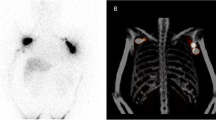Abstract
Background
The primary aim of axillary reverse mapping (ARM) is to prevent lymphedema by preserving arm versus breast axillary lymphatics. Concerns regarding feasibility and oncologic safety have limited the adoption of the technique. This prospective study was undertaken to investigate ARM in clinically node negative and node positive breast cancer patients.
Methods
A total of 184 patients underwent 212 ARM procedures: 155 sentinel lymph node biopsies (SLNB) without axillary lymph node dissection (ALND) (group 1) and 57 ALNDs with/without SLNB (group 2). ARM lymphatics were not preserved if they were a SLN, directly entered a SLN, or were within ALND boundaries during ALND.
Results
SLN with radioisotope alone was successful in 92 % of procedures (181 of 197). ARM identification was 47 % (73 of 155) in group 1. Criteria were met in 30 % (47 of 155) for preservation, and 25 % (38 of 155) were preserved. Of those who met preservation criteria, 81 % (38 of 47) were preserved. In group 2, ARM identification was 72 % (41 of 57); 7 met criteria for preservation and were preserved. Of the ARM nodes, 10 % (22 of 212) were SLNs (crossover). ARM nodes contained metastatic disease in one crossover and two nonsentinel ARM nodes in clinically node positive patients with N2/N3 disease.
Conclusions
ARM is a feasible technique for identification and preservation of axillary arm lymphatics with an acceptable incidence of SLN crossover. A larger sample size is needed to determine if ARM can reduce the incidence of lymphedema in patients undergoing SLNB alone and to confirm the absence of ARM metastases in clinically node negative patients undergoing ALND.
Similar content being viewed by others
References
Mansel RE, Fallowfield L, Kissin M, Goyal A, Newcombe RG, Dixon JM, et al. Randomized multicenter trial of sentinel node biopsy versus standard axillary treatment in operable breast cancer: The ALMANAC Trial. J Natl Cancer Inst. 2006;98:599–609.
Ashikaga T, Krag DN, Land SR, Julian TB, Anderson SJ, Brown AM, et al. Morbidity results from the NSABP B-32 trial comparing sentinel lymph node dissection versus axillary dissection. J Surg Oncol. 2010;102:111–8.
Thompson M, Korourian S, Henry-Tillman R, Adkins L, Mumford S, Westbrook K, et al. Axillary reverse mapping (ARM): a new concept to identify and enhance lymphatic preservation. Ann Surg Oncol. 2007;14:1890–5.
Boneti C, Korourian S, Diaz Z, Santiago C, Mumford S, Adkins L, et al. Scientific Impact Award: Axillary reverse mapping (ARM) to identify and protect lymphatics draining the arm during axillary lymphadenectomy. Am J Surg. 2009;198:482–7.
Noguchi M, Noguchi M, Nakano Y, Ohno Y, Kosaka T. Axillary reverse mapping using a fluorescence imaging system in breast cancer. J Surg Oncol. 2012;105:229–34.
Bedrosian I, Babiera GV, Mittendorf EA, Kuerer HM, Pantoja L, Hunt KK, et al. A phase I study to assess the feasibility and oncologic safety of axillary reverse mapping in breast cancer patients. Cancer. 2010;116:2543–8.
Nos C, Kaufmann G, Clough KB, Collignon MA, Zerbib E, Cusumano P, et al. Combined axillary reverse mapping (ARM) technique for breast cancer patients requiring axillary dissection. Ann Surg Oncol. 2008;15:2550–5.
Gobardhan PD, Wijsman JH, Van Dalen T, Klompenhouwer EG, van der Schelling GP, Los J, Voogd AC, et al. ARM: axillary reverse—the need for selection of patients. Eur J Surg Oncol. 2012;38:657–67.
Casabona F, Bogliolo S, Menanda M, Sala P, Villa G, Ferrero S. Feasibility of axillary reverse mapping during sentinel node biopsy in breast cancer patients. Ann Surg Oncol. 2009;16:2459–63.
Giuliano AE, McCall L, Beitsche P, Whitworth PW, Blumencranz P, Leitch AM, et al. Locoregional recurrence after sentinel lymph node dissection with or without axillary dissection in patients with sentinel lymph node metastases. Ann Surg. 2010;252:426–33.
Acknowledgment
I would like to thank Leah Jones for her invaluable assistance with data entry/data management.
Conflict of interest
None of the authors have a commercial interest in the subject of the study.
Author information
Authors and Affiliations
Corresponding author
Rights and permissions
About this article
Cite this article
Connor, C., McGinness, M., Mammen, J. et al. Axillary Reverse Mapping: A Prospective Study in Women with Clinically Node Negative and Node Positive Breast Cancer. Ann Surg Oncol 20, 3303–3307 (2013). https://doi.org/10.1245/s10434-013-3113-4
Received:
Published:
Issue Date:
DOI: https://doi.org/10.1245/s10434-013-3113-4




